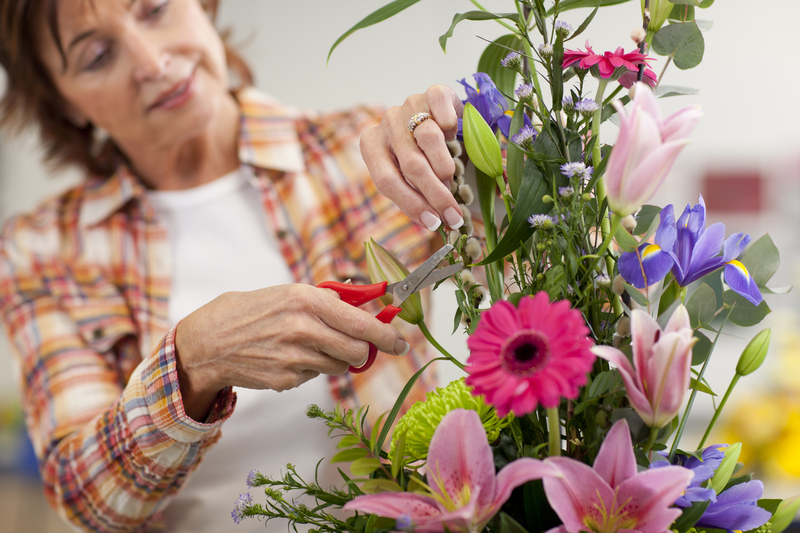Thriving Orchids: A Gardener's Guide
Posted on 01/07/2025
Thriving Orchids: A Gardener's Guide
Orchids are often seen as exotic, delicate plants, but with the right care, anyone can enjoy vibrant blooms in their own home or garden. If you're passionate about gardening and considering adding orchids to your collection, this comprehensive guide will help you nurture healthy, thriving orchids. From understanding the unique needs of orchid species to expert maintenance tips, you'll gain the confidence to create a stunning spectacle of blooms.
Understanding Orchids: What Makes Them Unique?
Orchids (family: Orchidaceae) represent one of the largest plant families in the world, boasting over 25,000 species and more than 100,000 hybrids. These captivating, mysterious plants have evolved to adapt to almost every ecosystem except glaciers and deserts. Diverse in appearance and growth habits, orchids are celebrated for their extraordinary flowers, intricate patterns, and often sweet fragrances.
Key Features of Orchids
- Epiphytic Lifestyle: Many orchids grow on trees (epiphytes), absorbing moisture and nutrients from air and rainfall rather than soil.
- Unique Roots: Orchid roots are thick, covered with a spongy layer called velamen that efficiently absorbs water and nutrients.
- Breathtaking Blooms: Orchid flowers are known for their striking symmetry and vibrant colors.
- Symbiotic Relationships: Orchids often rely on mycorrhizal fungi to support seed germination and growth in the wild.

Choosing the Right Orchids for Your Garden or Home
For successful orchid gardening, selecting species suitable to your environment is crucial. Some orchids thrive outdoors in mild, humid climates, while others prefer cozy indoor settings.
Popular Orchid Varieties for Beginners
- Phalaenopsis (Moth Orchid): Ideal for beginners, this variety has large, colorful blooms and adapts well to indoor conditions.
- Cattleya: Renowned for their bright, fragrant flowers, Cattleyas prefer high humidity and filtered light.
- Dendrobium: With over 1,000 species, Dendrobiums are versatile and come in a broad range of shapes and colors.
- Oncidium (Dancing Lady): These orchids deliver clouds of petite blooms and appreciate regular airflow.
- Paphiopedilum (Lady's Slipper): Characterized by unusual pouch-shaped flowers, they tolerate lower light levels.
Tip: Check if your desired orchid is suitable for indoor culture or best grown in a greenhouse/outdoor garden.
The Fundamentals of Thriving Orchid Care
Consistent care is the key to growing orchids that flourish year after year. Here's how to guarantee your success:
Lighting: Provide the Right Amount of Light
Most thriving orchids need bright, indirect light. Too much direct sunlight can scorch leaves, while too little will limit blooming. A general rule:
- Place orchids near an east or west-facing window.
- If window light is limited, use artificial grow lights to supplement.
- Monitor leaf color: vibrant green leaves indicate healthy light levels. Too dark signals insufficient light; yellowish or red-tinged leaves can mean excessive sun.
Watering Orchids: Less Is More
Orchids despise overwatering! Due to their unique roots, they need a special watering routine:
- Water when the potting mix is nearly dry, typically once a week. Frequency may vary with season and climate.
- Use room-temperature, ideally rainwater or distilled water free of chemicals.
- Let pots drain completely--never leave orchids standing in water.
Pro Tip: Stick your finger into the potting medium about an inch deep; if it feels dry, it's time to water.
Humidity Matters for Thriving Orchids
Most species enjoy humidity levels between 40% and 60%. Indoors, increase humidity using:
- Humidity trays: Place pots on a shallow tray filled with pebbles and water.
- Mist plants early in the day for a gentle boost.
- Use a room humidifier during dry seasons.
Grouping plants together also helps maintain consistent humidity.
Temperature: Striking the Right Balance
Understanding the natural habitat of your chosen orchid variety is fundamental.
- Phalaenopsis and Paphiopedilum: Prefer temperatures between 65?F to 80?F (18?C to 27?C) during the day, dropping slightly at night.
- Cattleyas and Oncidiums: Appreciate cooler nights (55?F to 60?F or 13?C to 16?C) to trigger blooming.
- Dendrobiums: Wide variety, but most thrive in intermediate ranges.
Fertilizing Your Orchids for Spectacular Blooms
Adopt a balanced, gentle feeding schedule:
- Fertilize with a weak, water-soluble orchid fertilizer ("quarter strength") every 2-3 weeks during the growing season.
- Pause or decrease frequency in winter or when plants are not actively growing.
- Flush pots with plain water once a month to prevent salt buildup.
Potting and Repotting Orchids
Thriving orchids require special containers and media since their roots must breathe:
Choosing the Right Potting Mix
The ideal orchid potting mediums include:
- Fir bark or pine bark chips
- Sphagnum moss
- Charcoal and perlite for aeration
- Coconut husk chips
Never use regular garden soil, as it smothers roots and promotes rot.
When and How to Repot Orchids
- Repot orchids every 1-3 years, or when the medium breaks down or the plant outgrows its container.
- Choose a transparent orchid pot to monitor root health and light exposure.
- Gently remove the plant, trim dead roots, and tuck into fresh mix.
- Water sparingly for a week after repotting to allow root wounds to heal.
Orchid Pests and Problems: Prevention and Solutions
Even experienced growers encounter challenges. The most common problems for orchid growers include:
Common Orchid Pests
- Mealybugs: Cottony pests sapping plant juices.
- Spider mites: Fine webbing and speckled, faded leaves.
- Scale insects: Wax-like bumps on leaves and stems.
- Aphids and thrips: Feed on new shoots and flower buds.
For mild infestations, wipe with a cotton swab moistened with rubbing alcohol. Isolate affected orchids and increase air movement.
Disease Troubleshooting
- Root rot/leaf spots: Usually caused by overwatering or poor ventilation. Remove affected parts, use fungicidal sprays, and improve air circulation.
- Bud blast: Unopened buds yellow and drop. This is often a stress response to sudden environmental changes or insufficient humidity.
How to Keep Orchids Healthy
- Check leaves and roots regularly for early warning signs of stress.
- Maintain good hygiene--clean tools, hands, and pots.
- Quarantine new plants before introducing them to your collection.
Encouraging Orchids to Flower Year After Year
The most rewarding part of orchid cultivation is seeing your plant blossom again and again. Encourage blooming by:
- Simulating natural seasonal changes--cooler nights in autumn trigger many orchids to spike.
- Feeding regularly during spring and summer, then reducing in winter.
- Letting plants rest--don't force water or fertilizer if your orchid is dormant.
- Ensuring roots have enough light exposure--roots photosynthesize too!
Patience is key; orchids sometimes take a year or more between flowerings. Avoid moving them unnecessarily once a flower spike appears.
Creative Orchid Displays and Companion Plants
Thriving orchid gardens are about more than just growing healthy plants--they're about displaying their beauty. Here are creative ways to showcase your collection:
Stylish Orchid Display Ideas
- Transparent pots and hanging baskets let roots shine while improving airflow.
- Orchid terrariums create humid mini-environments.
- Mount orchids on driftwood or cork for a naturalistic look mimicking wild habitats.
- Group different species for a lush, tropical effect.
Companion Plants for Orchids
- Ferns: Share humidity and grow well in similar light.
- Bromeliads: Thrive in the same conditions as most indoor orchids.
- Mosses: Increase ambient moisture around orchids.
When combining plants, ensure all species have compatible care requirements; avoid aggressive growers that may dominate or sap moisture.
Frequently Asked Questions About Thriving Orchids
How do I get my orchid to flower again?
Most orchids bloom annually or biannually. After blooming, provide a period of rest with less water and fertilizer, ensure a cool night temperature, ample indirect light, and don't repot until the resting period is complete.
What is the lifespan of an orchid?
With consistent care, many orchids can thrive and bloom for decades! They often outlive the original owner.
Do orchids need a special fertilizer?
Yes. Use a balanced orchid fertilizer, diluted to quarter strength, instead of standard houseplant feeds.
Why are my orchid leaves turning yellow?
Overwatering, poor drainage, lack of nutrients, or excessive sun can cause yellowing. Check each factor and adjust care accordingly.
Can I grow orchids outdoors?
In temperate to tropical climates, many orchid varieties, such as Cymbidium or Dendrobium, can thrive outside with protection from direct midday sun and winter cold. Always research the specific needs of your chosen species.

Pro Tips for Thriving Orchids
- Label your plants! With so many species, keeping track of specific needs is easier with clear, waterproof labels.
- Rotate orchids seasonally for optimum light, but avoid moving them when in bud or bloom.
- Monitor local weather: Sudden temperature drops or spikes can stress sensitive species.
- Join a local orchid society or online community to swap tips and troubleshooting advice.
- Take notes on watering, feeding, and blooming cycles to understand your plants' rhythms.
Conclusion: Cultivating Your Own Thriving Orchid Collection
With patience, observation, and a willingness to learn, orchid growing can be a joyful and rewarding gardening pursuit. From the enigmatic Phalaenopsis to show-stopping Cattleyas, the world of orchids offers endless opportunities for discovery. By understanding the basics--light, water, medium, and temperature--you'll unlock the door to lush, thriving orchids year after year.
Start your orchid journey today--with the right approach, you'll witness spectacular blooms and watch your collection flourish. Share your knowledge, experiment patiently, and enjoy one of nature's most exquisite gifts.
Latest Posts
How to Nurture Poinsettias Beyond the Holidays
Peony Flowers: An Exploration of Their Symbolic Colour Heritage
Thriving Orchids: A Gardener's Guide





